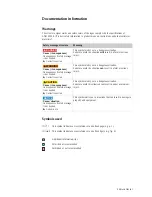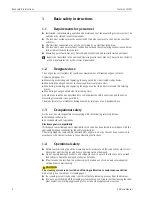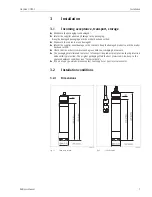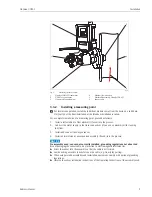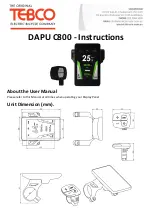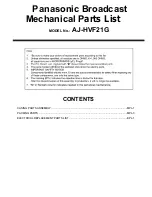
Basic safety instructions
Oxymax COS61
4
Hauser
1
Basic safety instructions
1.1
Requirements for personnel
►
Installation, commissioning, operation and maintenance of the measuring system must only be
carried out by trained technical personnel.
►
The technical personnel must be authorized by the plant operator to carry out the specified
activities.
►
The electrical connection may only be performed by an electrical technician.
►
The technical personnel must have read and understood these Operating Instructions and must
follow the instructions they contain.
►
Measuring point faults may only be rectified by authorized and specially trained personnel.
Repairs not described in the enclosed Operating Instructions may only be carried out directly
at the manufacturer's or by the service organization.
1.2
Designated use
The oxygen sensor is suitable for continuous measurement of dissolved oxygen in water.
Typical applications are:
• Measuring, monitoring and regulating the oxygen content in activated sludge basins.
• Monitoring the oxygen content in the sewage treatment plant outlet.
• Monitoring, measuring and regulating the oxygen content in public waters and fish farming
water.
• Monitoring of oxygen enrichment in drinking water.
Any other use than the one described here compromises the safety of persons and the entire
measuring system and is not permitted.
The manufacturer is not liable for damage caused by improper or non-designated use.
1.3
Occupational safety
As the user, you are responsible for complying with the following safety conditions:
• Installation instructions
• Local standards and regulations
Electromagnetic compatibility
With regard to electromagnetic compatibility, this device has been tested in accordance with the
applicable European standards for industrial applications.
The electromagnetic compatibility indicated only applies to a device that has been connected in
accordance with the instructions in these Operating Instructions.
1.4
Operational safety
►
Before commissioning the entire measuring point, make sure all the connections are correct.
Ensure that electrical cables and hose connections are not damaged.
►
Do not operate damaged products, and safeguard them to ensure that they are not operated
inadvertently. Mark the damaged product as defective.
►
If faults cannot be rectified, the products must be taken out of service and secured against
unintentional commissioning.
CAUTION
!
The cleaning system is not switched off during calibration or maintenance activities
Risk of injury due to medium or cleaning agent
►
If a cleaning system is connected, switch it off before removing a sensor from the medium.
►
If you are not switching off the cleaning system because you wish to test the cleaning function,
wear protective clothing, goggles and gloves or take other appropriate measures.


